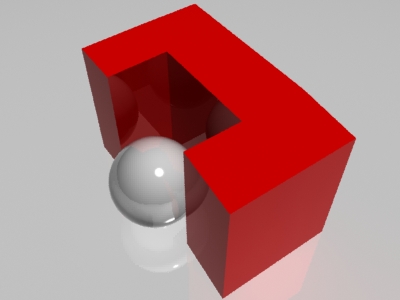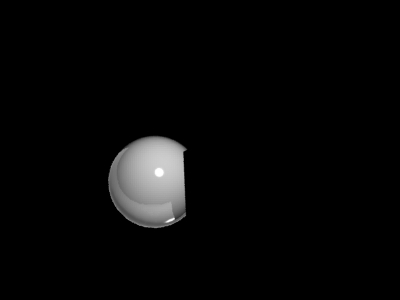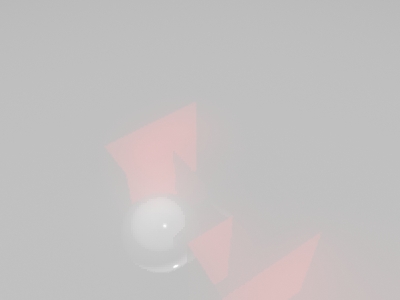The BRAWL² Tournament Challenge has been announced!
It starts May 12, and ends Oct 17. Let's see what you got!
https://polycount.com/discussion/237047/the-brawl²-tournament
It starts May 12, and ends Oct 17. Let's see what you got!
https://polycount.com/discussion/237047/the-brawl²-tournament
Pass with an Overlap?
I'll try to explain this as simply as I can.
If I render a scene with a sphere, a plane and an overlapping block, I get the render attached (see All In One Pass). I'm having trouble rendering out exactly the same thing in three passes; Pass 1: sphere, Pass 2: Block, Pass 3: Plane.
Here's how I do it:
- Sphere Pass: I uncheck 'Visible to Camera' for the plane and I apply a M/S/R material to the block. This results in the red block not being present in the reflections???
- Block Pass: I uncheck 'Visible To Camera' for both the block and the plane.
- Plane Pass: I uncheck 'Visible To Camera' for both the block and the sphere.
It's the sphere pass with an overlapping object that is problematic. By applying a M/S/R material I lose the object's reflection but I don't know how to get a render of the sphere, without the overlapped part, otherwise. This is for a more complicated animation so I need to know a proper method of doing this.
All In One Pass:

Sphere Pass (missing the reflection of red block):

Block Pass:

Plane Pass:

If I render a scene with a sphere, a plane and an overlapping block, I get the render attached (see All In One Pass). I'm having trouble rendering out exactly the same thing in three passes; Pass 1: sphere, Pass 2: Block, Pass 3: Plane.
Here's how I do it:
- Sphere Pass: I uncheck 'Visible to Camera' for the plane and I apply a M/S/R material to the block. This results in the red block not being present in the reflections???
- Block Pass: I uncheck 'Visible To Camera' for both the block and the plane.
- Plane Pass: I uncheck 'Visible To Camera' for both the block and the sphere.
It's the sphere pass with an overlapping object that is problematic. By applying a M/S/R material I lose the object's reflection but I don't know how to get a render of the sphere, without the overlapped part, otherwise. This is for a more complicated animation so I need to know a proper method of doing this.
All In One Pass:

Sphere Pass (missing the reflection of red block):

Block Pass:

Plane Pass:

Replies
@Slum: I don't understand what you mean about material ID passes here? The block and sphere pass would have alpha masks rendered out with them. But to mask out that near corner of the sphere, if I use the block's alpha it will mask out the far side of the sphere too.
I could remove part of the mask in comp but this wouldn't work well in a complex animation. I guess I could render the sphere again with the block set to 'invisible from camera', then use the alpha from the first sphere to mask out the new one. It just seems like a very complicated way of doing something that must be a common issue in the industry.
If anyone can do it, please show. I'm interested in knowing what you meant Slum.
@Cryrid: I'm not sure how to do that but I think it may be the answer to my next question.
@Perma: Thanks a lot for the image. Yeah, I think I have an inbuilt thing not to read instruction sheets
@Bbob: That's the prob I was having with the M/S/R material; as the M/S/R had replaced the original material I was not getting true reflections.
The masks for the different object IDs are great. If I was to render out the whole scene, and separate it using these masks, then in comp I would have a load of 'whole scene' layers containing unnecessary masked info. This would mean much bigger file sizes. How can I render out objects separately along with their masks without losing their interaction with other objects?
Edit: Ok, I think the way to do it is to render out the whole scene with object ID passes for masks and then render out the objects separately with the other objects set to 'invisible to camera'. (Cryrid I think it's the same thing). Is there a way to set all the other objects to 'invisible to camera' without having to do them separately? If anyone has a better way, please say.
ps. What's up with Polycount, it keeps logging me out?
I'd achieve this result with the matte method given but it would also mean that for every object, the whole scene would be rendered and only one object would be masked out. Wouldn't this be overkill on large animations (file size)?
Ps. that last question you asked, I want it occluded by other non-rendered objects.
Whenever I've seen comping videos in the past, I always thought that individual objects were rendered out on a plain background with their alpha.